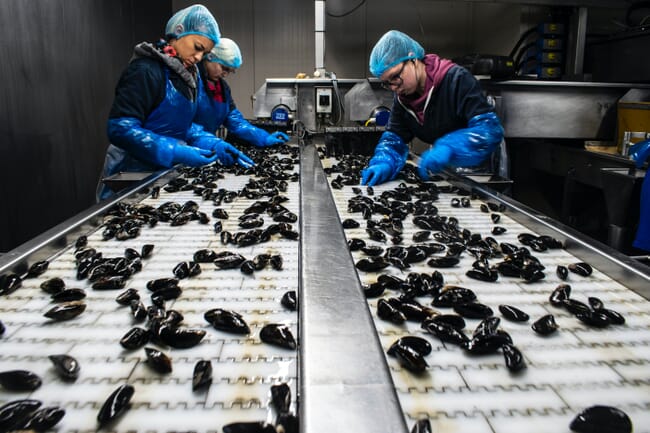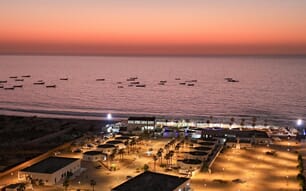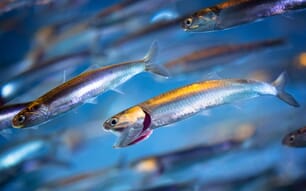
© Paul Einerhand, Unsplash
Launched today by experts from the Blue Food Assessment, the new research compiles and analyses a range of existing national data to uncover the four key roles that aquatic (blue), foods can play to improve national food systems’ performance and sustainability. This, in turn, has broader implications for financiers, processors, retailers, development organisations and the food producers themselves.
“Blue foods can play important roles in our diets, societies and economies, but what exactly this looks like will differ greatly from one country and local setting to another,” said Beatrice Crona, lead author, professor at the Stockholm Resilience Centre at Stockholm University, and co-chair of the Blue Food Assessment, in a press release.
“Our goal is for policymakers to fully understand the diverse contributions that blue foods can make, but also for them to consider the trade-offs that need to be negotiated to really make the most of the opportunities that blue foods provide.”
Published in Nature and entitled “Four ways blue foods can help achieve food system ambitions across nations”, the paper looks at the potential for aquatic foods to deliver benefits and improvements across four policy dimensions: B12 and omega-3 nutrient deficiency; high rates of cardiovascular disease associated with excessive red (particularly processed) meat consumption; high environmental impacts; and climate adaptation and resilience to safeguard the contribution of blue food systems to nutrition, just economies, livelihoods and cultures.
For instance, researchers found that policymakers in countries with high environmental food footprints and high levels of cardiovascular disease – typified by developed countries in Europe and North America – should focus on improving production and access to blue foods, which can act as a substitute for the consumption of more impactful red meats.
In contrast, the paper suggested that policymakers in nations characterised by high environmental food footprints and high nutrient deficiencies could choose to support greater diversity of blue food production and promote lower cost blue foods. The research indicated farmed bivalves or small pelagic fish, such as sardines and herrings, can benefit less affluent populations while having low environmental footprints.
“By further customising the different parameters in the online tool, decision-makers can explore the blue food policies most relevant for their national setting and use the paper to inspire blue food policies that can overcome existing environmental and nutritional challenges,” said Jim Leape, co-director of the Stanford Center for Ocean Solutions, a key partner in the Blue Food Assessment.
The role of aquaculture
In response to aquaculture-specific questions from The Fish Site, Malin Jonell, Stockholm Resilience Centre, Stockholm University, Royal Swedish Academy of Sciences and member of the Blue Food Assessment, and Max Troell, The Beijer Institute, Royal Swedish Academy of Sciences, Stockholm Resilience Centre and member of the Blue Food Assessment, added the following insights.
There's a mention of farmed bivalves being promising candidates as blue foods for developing countries, but can you go into more detail of some of the farmed blue foods that have the greatest potential to help combat the four main issues highlighted in the paper?
"The paper communicates that there are clear trade-offs between different sustainability targets - implying that no one species/system is optimal for all national or sub-national contexts. The specific question about bivalves in the tropics is interesting. Bivalve farming has mainly been developed for temperate waters and it is here most production takes place. Challenges for bivalve farming in the tropics involve oligotrophic waters, pollution and exposure to rough farming conditions. There are, however, different candidate species that are suitable and are being farmed although at small volumes. An increased focus on these species (also including the potential of aquatic plants) could result in production benefitting low-income groups and those being nutrient deficient. Cultural challenges may exist for transforming diets with higher inclusion of such species.
"The larger set of Blue Food Assessment papers provides an in depth assessment of the role of different farmed species, both from a nutritional perspective (policy objective 1 & 2, see also Golden et al, 2021) and from an environmental perspective (policy objective 3, Gephart et al, 2021). Data from these papers show that bivalves and oysters, as well as salmonids, are particularly attractive from a nutritional point of view, and that non-fed aquaculture (including bivalves and non-fed carp) has a very low carbon footprint. When it comes to policy objective 4 (safeguarding contributions to nutrition, just economies, livelihoods and cultures under climate change), we would like to emphasise the importance of maintaining diversity in production (both in terms of species and production systems) as well as protecting small-scale producers.
Can you provide some examples of how aquaculture can change/evolve to help meet these goals?
"This paper is not specifically looking at pathways for transforming the aquaculture sector to reach the policy objectives. However, it builds on our earlier work (eg Gephart et al. 2021 and Henriksson et al. 2021) suggesting that shifting to species with smaller environmental impacts, changing feed composition (eg to deforestation-free soy, fisheries by-products, or insect meal, or other innovative feed resources) and improving husbandry practices (including also genetic improvements) is key for improving the sector.
"However, we also emphasise that lowering feed conversion ratios (an important strategy for improving the local environmental performance) will require acquisition of high-quality feed ingredients, which may have consequences for sustainable and ethical resource management. For instance, feeding farmed animals human grade feed will reduce the food volume available for human consumption," they explained.
Background
The landmark Blue Food Assessment is a comprehensive body of academic research aimed at informing the sustainable contribution of aquatic foods towards the healthy diets of the future.
The assessment’s published research has already shown that 93 countries have 10 per cent or more of their population exposed to nutrient deficiencies, despite blue food availability, and that access to more affordable blue foods could prevent 166 million micronutrient deficiencies worldwide.
The assessment has also shown that blue food consumption is set to increase by 80 per cent in edible weight by 2050, with blue foods already supporting the livelihoods of up to 800 million people worldwide. Yet the opportunities to take advantage of the positive contribution of blue foods to healthy and sustainable diets have not yet been fully realised.
This latest paper brings together the insights from the entire Blue Food Assessment to provide a solid scientific base, and an interactive tool, to help policymakers explore blue food related data from their own nations, and be inspired to craft policies and actions that can realise the contributions blue foods can make to food systems around the world.




